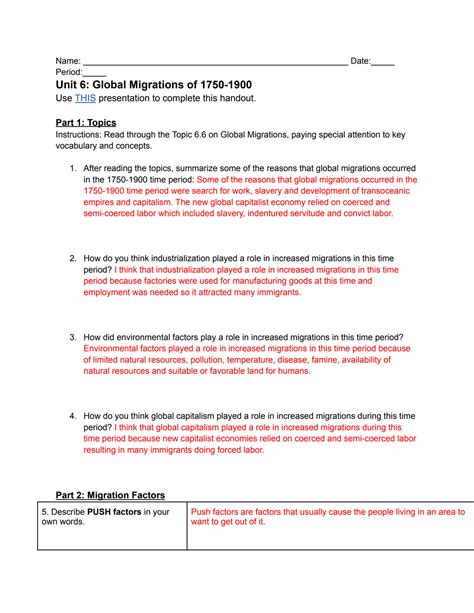During the period from 1750 to 1900, the world witnessed unprecedented levels of global migration. Millions of people left their homelands in search of better opportunities, fleeing poverty, persecution, and war. This mass movement of people had a profound impact on the societies of both the sending and receiving countries.

Causes of Migration
The primary drivers of migration during this period were economic factors. The Industrial Revolution in Europe created a demand for labor in new industries, attracting workers from rural areas and abroad. Additionally, the rise of capitalism and the enclosure of common lands forced many peasants off their land, leading them to seek work in urban centers or to emigrate overseas.
Political and religious persecution also played a significant role in migration. Governments in Europe and Asia suppressed dissent, leading many people to seek refuge in more tolerant societies. Religious minorities, such as Jews and Huguenots, were particularly vulnerable to persecution and often emigrated in search of freedom of worship.
Patterns of Migration
The vast majority of migration during this period was from Europe to other continents. The United States, Canada, and Australia were major destinations for European emigrants, particularly from countries such as Ireland, Germany, and Italy. These migrants often settled in urban areas, where they worked in factories, mines, and other industries.
However, migration was not limited to Europe. There were also significant flows of people from Asia, Africa, and the Middle East. Chinese workers emigrated to Southeast Asia, the Americas, and Europe, while Indian laborers were recruited to work on plantations in British colonies. Africans were forcibly transported to the Americas as slaves, and millions perished during the transatlantic slave trade.
Impact of Migration
The mass migration of the 1750-1900 period had a profound impact on the societies of both the sending and receiving countries. In Europe, migration helped to alleviate population pressures and provide labor for industrializing economies. In the United States, immigration contributed to the rapid growth of the country’s population and economy. However, it also led to social tensions and the rise of anti-immigrant sentiment.
In the sending countries, migration often had negative consequences. The loss of skilled workers and entrepreneurs weakened their economies and contributed to rural depopulation. Additionally, the separation of families and communities had a psychological toll on those left behind.
Table 1: Major Destinations of European Emigrants, 1820-1924
| Destination | Number of Immigrants |
|---|---|
| United States | 30 million |
| Argentina | 6.6 million |
| Brazil | 4.5 million |
| Canada | 4.2 million |
| Australia | 2.3 million |
| South Africa | 1.3 million |
Table 2: Major Sources of Asian Emigrants, 1850-1940
| Source | Destination | Number of Emigrants |
|---|---|---|
| China | Southeast Asia, Americas, Europe | 10 million |
| India | Southeast Asia, Caribbean, Africa | 5 million |
| Japan | Americas, Europe | 2 million |
| Korea | Americas, Japan | 1 million |
Table 3: Transatlantic Slave Trade, 1550-1865
| Region | Number of Slaves Traded |
|---|---|
| West Africa | 10.5 million |
| Central Africa | 4.7 million |
| East Africa | 3.8 million |
| Southern Africa | 1.2 million |
Table 4: Impact of Migration on the United States, 1850-1900
| Indicator | 1850 | 1900 |
|---|---|---|
| Population | 23 million | 76 million |
| Foreign-born Population | 22% | 36% |
| Urbanization Rate | 15% | 50% |
| Industrial Production | $1.1 billion | $13 billion |
Tips and Tricks
- Research the specific reasons for migration: Consider the economic, political, and social factors that drove people to leave their homelands.
- Examine the patterns of migration: Trace the routes taken by migrants and identify the major destinations.
- Analyze the impact of migration: Explore the economic, social, and cultural effects of migration on both the sending and receiving countries.
Common Mistakes to Avoid
- Assuming that migration was always a voluntary process: Forced migration, such as the transatlantic slave trade, was a major factor during this period.
- Overgeneralizing about the experiences of migrants: The experiences of migrants varied widely depending on their origin, destination, and social status.
- Ignoring the negative consequences of migration: While migration could bring opportunities, it could also lead to social tensions, discrimination, and economic exploitation.
Conclusion
The global migrations of 1750-1900 were a transformative event in world history. They shaped the demography, economies, and societies of both the sending and receiving countries. By understanding the causes, patterns, and impact of migration, we can better grasp the complexities of human mobility and its lasting legacy.
